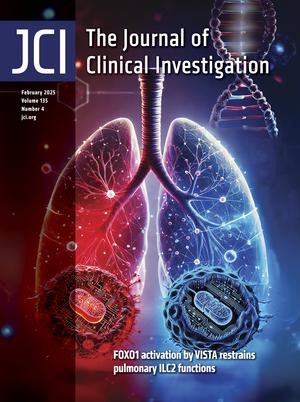J Clin Invest. 2025 Jun 10:e188819. doi: 10.1172/JCI188819
Wilms’ tumor 1 impairs apoptotic clearance of fibroblasts in distal fibrotic lung lesions
Harshavardhana H Ediga1, Chanukya P Vemulapalli1, Vishwaraj Sontake2, Pradeep K Patel1, Hikaru Miyazaki2, Dimitry Popov2, Martin B Jensen2, Anil G Jegga3, Steven K Huang4, Christoph Englert5, Andreas Schedl6, Nishant Gupta1, Francis X McCormack1, Satish K Madala7
Affiliations
1Division of Pulmonary, Critical Care and Sleep Medicine, Department of Inte, University of Cincinnati, Cincinnati, United States of America.
2Gordian Biotechnology, San Francisco, United States of America.
3Division of Biomedical Informatics, Cincinnati Children Hospital Medical Center, Cincinnati, United States of America.
4Division of Pulmonary and Critical Care Medicine, Department of Internal Me, University of Michigan Medical School, Ann Arbor, United States of America.
5Molecular Genetics Lab, Leibniz Institute on Aging – Fritz Lipmann Institute, Jena, Germany.
6Institute of Biology Valrose, University of Sophia-Antipolis, Nice, France.
7Division of Pulmonary, Critical Care and Sleep Medicine, Department of Inte, University of Cincinanti, Cincinnati, United States of America.
Abstract
Idiopathic pulmonary fibrosis (IPF) is a fatal fibrotic lung disease characterized by impaired fibroblast clearance and excessive extracellular matrix (ECM) protein production. Wilms’ Tumor 1 (WT1), a transcription factor, is selectively upregulated in IPF fibroblasts. However, the mechanisms by which WT1 contributes to fibroblast accumulation and ECM production remain unknown. Here, we investigated the heterogeneity of WT1-expressing mesenchymal cells using single-nucleus RNA sequencing of distal lung tissues from IPF patients and control donors. WT1 was selectively upregulated in a subset of IPF fibroblasts that co-expressed several pro-survival and ECM genes. The results of both loss-of-function and gain-of-function studies are consistent with a role for WT1 as a positive regulator of pro-survival genes to impair apoptotic clearance and promote ECM production. Fibroblast-specific overexpression of WT1 augmented fibroproliferation, myofibroblast accumulation, and ECM production during bleomycin-induced pulmonary fibrosis in young and aged mice. Together, these findings suggest that targeting WT1 is a promising strategy for attenuating fibroblast expansion and ECM production during fibrogenesis.
DOI: 10.1172/JCI188819

